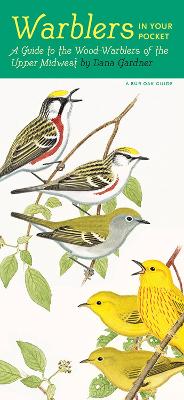A Bur Oak Guide
2 total works
Robins may be the official harbingers of spring, but the arrival of the wood-warbler signifies the real beginning of the season. These brightly colored songsters, most of whom have migrated extremely long distances to reach their summer nesting grounds, appear like animated jewels from treetops to shrubs to ground throughout the Midwest. Adult males in fresh spring plumage are particularly striking: the buttery yellow of the commonly seen yellow warbler; brilliant orange of the Blackburnian and bright gold of the prothonotary; rich chestnut of the Cape May, bay-breasted, and chestnut-sided; the blue of the northern parula, cerulean, and black-throated blue make these birds a joy to encounter.
This newest addition to Iowa’s popular series of laminated guides—the twenty-eighth in the series—illustrates the thirtyeight species of warblers that occur in the Upper Midwest states of Minnesota, Illinois, Nebraska, Kansas, North Dakota, South Dakota, Iowa, Indiana, Michigan, Ohio, and Wisconsin. For each species, artist Dana Gardner provides length, range, and habitat; he illustrates male, female, and immature birds where plumage varies; and he includes birds similar to warblers such as kinglets and vireos.
For all their brilliance, warblers can be hard to identify, particularly in the fall—the phrase “confusing fall warblers” was coined for a reason—and when they are in immature plumage. Quickmoving and often found in treetops, they can be challenging even in spring, and the drabber colors of the young birds of the season and of many fall adults can make identification difficult. The illustrations and descriptions in Warblers in Your Pocket will be a most welcome reference for bird watchers throughout the Midwest.
This newest addition to Iowa’s popular series of laminated guides—the twenty-eighth in the series—illustrates the thirtyeight species of warblers that occur in the Upper Midwest states of Minnesota, Illinois, Nebraska, Kansas, North Dakota, South Dakota, Iowa, Indiana, Michigan, Ohio, and Wisconsin. For each species, artist Dana Gardner provides length, range, and habitat; he illustrates male, female, and immature birds where plumage varies; and he includes birds similar to warblers such as kinglets and vireos.
For all their brilliance, warblers can be hard to identify, particularly in the fall—the phrase “confusing fall warblers” was coined for a reason—and when they are in immature plumage. Quickmoving and often found in treetops, they can be challenging even in spring, and the drabber colors of the young birds of the season and of many fall adults can make identification difficult. The illustrations and descriptions in Warblers in Your Pocket will be a most welcome reference for bird watchers throughout the Midwest.
Waterfowl in Your Pocket is a welcome aid to identifying the many colorful and intriguing water birds of the midwestern states, from the Great Lakes west to the Dakotas, east to Ohio, and south to Kansas and Missouri. Illustrator Dana Gardner has created fourteen panels showing fifty-one species of ducks, geese, swans, grebes, pelicans, coots, cormorants, moorhens, and loons swimming and flying with complete plumage variations - dark phases, light phases, and juvenile and adult male and female forms in summer and winter. The text also includes length, common and scientific names, and frequency and distribution.Whether flying high overhead in the fall or swimming in a nearby lake in the summer, waterfowl are notoriously difficult to identify, and Gardner has worked hard to make this guide useful for beginning birders as well as those more experienced in the field. Keep binoculars and ""Waterfowl in Your Pocket"" in your car or backpack - or pocket! - during spring and fall migration and summer nesting season for help in identifying such captivating water birds as greater white-fronted geese and tundra swans during spring and fall migration, male wood ducks and mallards in breeding plumage, immature and female red-breasted mergansers and snow geese, and uncommon winter visitors such as eiders and scoters.

